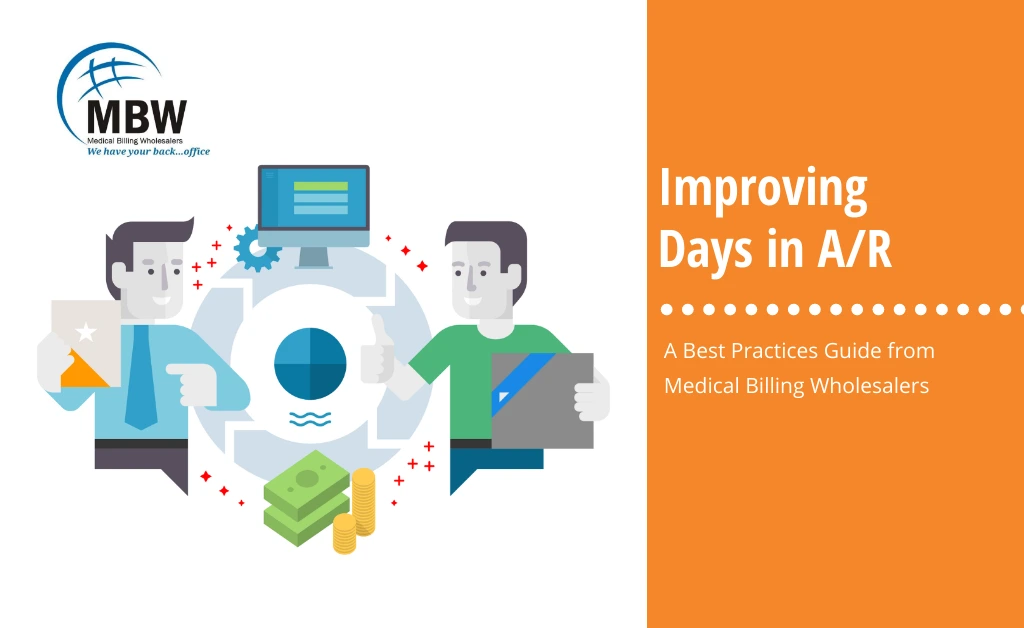Measuring Days in Accounts Receivable

The days in accounts receivable (A/R) is a critical performance indicator that measures the average time taken for a claim to be paid based on average daily charge volume. While the measure may vary for different types of care and medical specialties, the suggested benchmark by the Medical Group Management Association (MGMA) is fewer than 40 days.
Calculating Days in A/R is pretty simple.
Just divide your total accounts receivable by your average daily gross charges i.e., total gross charges for the past calendar year divided by 365 days.
Common factors that lead to increased days in A/R are:
-
Claim filing delays
-
Ineffective determination of eligibility
-
Increased claim rejections
-
Increased denials and inefficient appeals process
-
Incorrect coding
-
Data entry errors
-
Credentialing delays
-
Incorrect posting process
As you would notice, most of these issues are easily addressable.
Best practices to reduce days in A/R
Let us now look at how you can achieve the MGMA benchmark through a set of best practices that address the entire revenue cycle chain.
-
Effective eligibility verification and prior authorization along with accurate capture of demographic information. Physician front offices do not always do a great job of capturing patient information. Scheduling/front-office teams need to ensure the following information is available and effectively captured.
-
-
The correct address of the patient, phone number and email
-
Verification if the insurance is active and the co-payment/deductible amounts required
-
Informing patients about their payment responsibilities in advance.
-
-
On-time eligibility verification or outsource demographics entry and eligibility verification. The eligibility should be verified 2-3 days before the patient visit, and prior authorization obtained for specific treatments. This ensures that the information is updated and any coverage gaps are identified early on in the cycle. Outsourcing eligibility verification processes or investing in technologies that help you determine on-time eligibility is recommended.
-
Physician Credentialing. Ensure that the physicians are credentialed for the largest payers in your geographic location. Keep a catalog of physician credential information and update credentials on time.
-
Patient Responsibility and Patient Collections. Patients pay a massive % of the cost of care today. The effectiveness of the front office is tested using the upfront payments are collected at the time of service and followed upon effectively.
-
-
Communicate Patient responsibility for payments before the patient visit
-
Collect all co-payments at the time of service
-
Automate patient statement generation processes and send out patient statements on-time
-
Schedule reminder calls with patients 1-2 hours after the statements are sent.
-
-
Timely billing. Filing medical claims on-time is, perhaps, one of the most critical activities when you set out to improve your revenue cycle efficiencies. Insurance companies have timely filing limits. Inordinate delays between the date of service, date of billing, and date of claims filing result in a significant % of denials.
-
Coding Services. Inaccurate coding is another reason for a significant % of claim denials. ICD-10-CM diagnosis and CPT procedure codes enable insurance systems to understand the type of ailment and care provided, and therefore leading to faster payment. Additionally, a review of the processes adopted for clinical documentation can help identify potential areas of revenue leakage and help physicians improve clinical documentation.
-
Getting real about Value-based care. With the rise of value-based care, the clinical quality, and the quality of the practice’ AR data is under increased focus. Practices must now track multiple payer contracts and manage quality metrics reporting, requiring additional resource allocation.
-
Get an A/R management team. Whether you manage your A/R in-house or outsource it to a third party, utilize A/R data to get actionable insights through the following:
-
-
Determine A/R days by specific payers and the overall days in A/R. This will help you identify payer-specific trends. You may also do the same for particular medical specialties in case of large practices.
-
Perform trend analytics. Any exercise for improvement requires an understanding of how the team has performed in reducing days in A/R
-
Identify top denial reasons. Conduct an exercise to catalog denial reasons and ensure that these issues are addressed at the source.
-
Initiate timely Write-offs and hand-off to collections agencies. Older aging buckets i.e., A/R greater than 90 days, require specific actions to be taken. Either these claims need to be written off or sent to the third party collection agencies in a compliant manner. If no action is taken, this is the money that the practice stands to lose.
-
Draft Accounts Receivable Policies. The involvement of the CFO or the finance leader for the practice in drafting policies for follow-up, collections, write-offs, etc. is essential. Lack of clearly laid down policies and ineffective monitoring of the policy guidelines lead to indecision by the A/R team members, which in turn leads to piled up claims.
-
-
Run-down old A/R each month. Set aside a couple of days each month to tackle old A/R. If you are outsourcing A/R follow-up and denial management, keep a watch on all aging buckets and create focused clean-up activities for the specific old A/R buckets – for different payers, and medical specialties.
-
Give feedback to the clinicians. A constant improvement exercise is incomplete without the involvement of the clinical team. Work with physicians to help them understand their clinical documentation responsibilities through training and feedback loops.
The key to improving days in A/R lies in diligent actions, including timely identification of issues, improved focus on collecting the money owned by utilizing analytics, and an agile, responsive A/R team to back you up.

